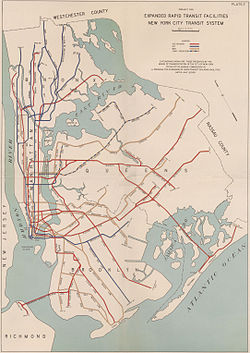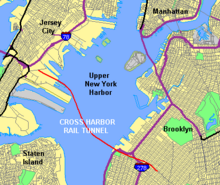Staten Island Tunnel
[5] The tunnel would have gone near the foot of Vanderbilt Avenue on Staten Island to Bay Ridge in Brooklyn, traveling 1+1⁄4 miles (2.0 km) at a depth of 35 feet (11 m) below the narrows.
[1][10][11][12][13] Under the Dual Contracts, three routes were proposed—two to Brooklyn and one to Manhattan—which would connect the Staten Island Railway's rapid transit service (SIRT) to existing subway lines.
[6][8][13] The Manhattan proposal, often called the "direct route," would have connected with the Interborough Rapid Transit Company (IRT)'s lines under Battery Park, near the current Brooklyn–Battery Tunnel.
Because of this, the high costs of the potential tunnel, and the relatively small population of Staten Island, the Manhattan route was considered impractical.
[9] Both of the shorter, Brooklyn proposals would have connected to the Brooklyn–Manhattan Transit Corporation (BMT)'s Fourth Avenue subway, constructed in 1914 during the Dual Contracts.
[23][24] The Bay Ridge-based plan was ultimately selected, running between 65th Street/Shore Road in Brooklyn and the St. George Ferry Terminal in Staten Island.
[25] In the final plans, each tunnel was designed to be 24 feet (7.3 m) wide to accommodate freight cars in addition to passenger service, with freight trains coming from the Long Island Rail Road (LIRR)'s Bay Ridge Branch (terminating just north of the tunnel site) and the Staten Island Railway's connection with rail lines from New Jersey.
[11][29] In May 1922, John Hylan launched a new plan for the freight and passenger tunnel, and the Board of Estimate recommended that $4.08 million be initially appropriated for the project.
Provisions would be made for connections with the subway system's Fourth Avenue Line, even though the Transit Commission refused to be involved with the plans.
[30] A groundbreaking ceremony was held by New York City Mayor John Hylan on April 14, 1923 in Bay Ridge[1][26][31] and in Staten Island on July 19.
[33] In addition, in preparation for the tunnel, the SIRT purchased one hundred ME-1 subway cars built to BMT specifications and electrified its three passenger branches.
[6] Officially, the plan was delayed due to lack of funding,[2][18] but Hylan and New York City Board of Transportation (BOT) Chairman John Delaney also wanted to secure freight service for the tunnel.
[6] Nonetheless, on October 2, 1925,[37] the 95th Street subway station, which was built mainly in anticipation for the Staten Island Tunnel, was opened.
[38] The station was built with a false wall at its south end, intended for either a planned extension to 100th or 101st Streets[39] or a line leading to a future Fort Hamilton-based tunnel.
[1][6][9][31] The South Street Shaft in Staten Island was filled in 1946 during post-World War II renovations of Saint George Terminal.
[9][12][29][44] An updated proposal in 1931 had the connection to the IND at the current Smith-Ninth Streets station, with the tunnel traveling north from Staten Island through Red Hook and Gowanus.
[10] The Church Avenue connection would have utilized the lower level yard just south of the station, currently used to relay terminating G trains.
[6][9][10] In 1945, the tunnel between New Brighton and the BMT Fourth Avenue Line in Brooklyn was submitted by the Board of Transportation to the City Planning Commission as part of the 1946 budget, this time costing $50.61 million.
[56] Supporters stated that a rail tunnel would improve quality of life for Staten Islanders, reduce traffic, and increase the attractiveness of the borough for investment.
[6][11][59] As a precursor to the planned project, which could cost up to $11 billion to build, the Port Authority of New York and New Jersey (PANYNJ) compiled a Tier 1 Draft Environmental Impact Statement (DEIS) in November 2014.
These included an option for a tunnel directly from Greenville Yard to the Bay Ridge Branch, and a link from New Jersey to Manhattan.
In their advertisements, the company stated, "Five or ten years from now—when the subway to Staten Island is built—… some Doubting Thomases of New Yorkers who don't buy will be shedding tears at their lack of foresight.
This plan proposed a subway line running along the SIRT North Shore Branch and John F. Kennedy Boulevard in New Jersey, before connecting with the Hudson and Manhattan Railroad (today's PATH train) at Exchange Place.
[66] Boring work for the vehicular tunnels started in November 1930,[67] but in January 1932, construction was delayed indefinitely due to a lack of money.
[69] In 1936, the plan for a vehicular tunnel under the Narrows was brought up again when Mayor La Guardia gained authorization to petition Congress for a bridge across the strait.
[72] After World War II ended in 1945, the New York City Planning Commission estimated that construction of the Narrows Tunnel would cost $73.5 million.

